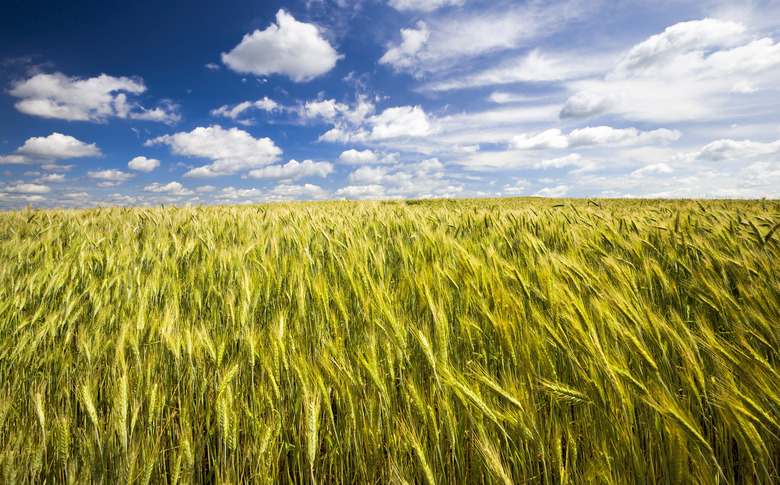Where Are The Temperate Zones Located?
Regions of Earth can be divided into zones based on their proximity to the equator: tropical, temperate and polar. The temperate zone lies between the tropics and the polar regions and experiences a wide range of temperature and precipitation where four distinct seasons are common. Every continent except Antarctica has at least a small portion of land in the temperate zone. Regions that lie exclusively in the temperate zone include the continental U.S., most of Canada and Europe, Central Asia, southern South America and southern Australia.
Parallels of Latitude
Parallels of Latitude
Parallels of latitude run from 0 degrees at the equator to 90 degrees N at the north pole and 90 degrees S at the South Pole. Degrees of latitude increase as you move away from the equator and toward the poles. The temperate zone lies in the middle latitudes, in the regions of the Earth between the tropics and the polar regions. Latitude is a factor in classifying zones because it correlates to the amount of sunlight an area receives.
Climate Zones
Climate Zones
In the early 1900s, Wladimir Koppen identified and defined climate zones of Earth: tropical, dry, temperate, continental, polar and highland. Climate zones are classified by the average temperature, amount of rainfall and type of climate they have. Latitude, elevation and the presence of nearby mountains or large bodies of water help determine climate zone because of their effects on weather patterns.
The Non-Temperate Zones
The Non-Temperate Zones
The tropical zone is located at the equator and extends approximately 25 degrees to the north and south of the imaginary line. Tropical zones get more than 59 inches of rain per year. The temperature normally stays above 64 degrees Fahrenheit year-round. Dry zones receive little rainfall, and precipitation evaporates quickly. These regions are found farther away from the equator, around 20-35 degrees north and south of the equator. The polar zones, located in the high latitudes above 60-70 degrees north and south, are coldest. Temperatures generally do not exceed 50 degrees F, even in summer. Highland zones are much smaller than other zones. They are found in mountainous regions where the high elevation causes weather that is generally cool and windy and can change quickly. In the United States, highland zones are located in isolated areas of the Rocky Mountains.
Temperate Zone
Temperate Zone
In broadest sense, the temperate zone encompasses the areas of Earth that lie between the tropical zone and the polar zones. The temperate zone is sometimes called the mid-latitudes because they exist roughly between 30 degrees and 60 degrees north and south latitude. There is a greater variety in climates in the temperate zone, but many regions can be classified as either moist-continental or moist-subtropical.
Temperate Climate
Temperate Climate
The moist-subtropical climates of the temperate zone are often located near large bodies of water or far away from large mountain ranges. These regions are found at lower latitudes within the temperate zone. The winters are cool but relatively mild and summers are warm, wet and stormy. The Southeast region of the U.S. falls in this zone, as well as large portions of China, Brazil and Argentina.
The moist-continental climate zones have cold, blustery winters with plenty of snow and strong wind. Summer here is cooler than in the subtropical zones. Continental climates are located at the higher latitudes within the temperate zone and are closer to the poles than the subtropical climates. The Midwest region of the U.S, southern Canada and central Europe are classified in this climate zone.
Temperate Forests
Temperate Forests
The middle latitudes of the temperate zone experience a greater variability in temperature and precipitations than the polar or tropical zones. Although there is less biodiversity in the temperate zone than the tropical zone due to colder temperatures, 25 percent of Earth's forests reside in the temperate zone. These include both deciduous and coniferous forests. Above 50-55 degrees N latitude there are only conifer forests in the colder taiga biome. Most temperate forests are located in the Northern Hemisphere, but some temperate forests exist in New Zealand, southern Australia, South Africa, and southern Chile and Argentina. Rainforest can be found along some coastal areas in the temperate zone, such the Pacific coast in North America.
Temperate Grasslands and Deserts
Temperate Grasslands and Deserts
Dryer regions of the temperate zone exist in the interior areas of continents, far from moist coastal air. The biomes do not get enough rainfall to support forests. Grasses thrive in areas with adequate precipitation, such as the prairies of North America, the steppes of Asia, veldt of South Africa and pampa of South America. Closer to the tropics, the temperate deserts exist in the lower latitudes of the temperate zone. Like tropical deserts, they receive less than 10 inches of annual precipitation. But unlike their tropical counterparts, experience cold temperatures in winter.
Cite This Article
MLA
Mentzer, A.P.. "Where Are The Temperate Zones Located?" sciencing.com, https://www.sciencing.com/temperate-zones-located-5882122/. 22 November 2019.
APA
Mentzer, A.P.. (2019, November 22). Where Are The Temperate Zones Located?. sciencing.com. Retrieved from https://www.sciencing.com/temperate-zones-located-5882122/
Chicago
Mentzer, A.P.. Where Are The Temperate Zones Located? last modified March 24, 2022. https://www.sciencing.com/temperate-zones-located-5882122/
